<< Previous | Displaying results 4401-4450 of 6769 for "" | Next >>
World War II began with the German invasion of Poland in September 1939 and ended in Allied victory in Europe with the German surrender in May 1945. May 8 was proclaimed VE (Victory in Europe) Day. In this footage, United States president Harry S. Truman proclaims victory in Europe and promises to continue the war in the pacific until the unconditional surrender of Japan.
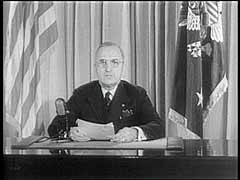
After the Munich agreement and the Czech surrender of the Sudetenland to Germany, German authorities expelled these Jewish residents of Pohorelice from the Sudetenland to Czechoslovakia. The Czech government, fearing a flood of refugees, refused to admit them. The Jewish refugees were then forced to camp in the no-man's-land between Bruno and Bratislava on the Czech frontier with Germany.
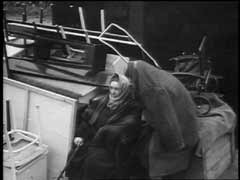
Delegates of 32 countries assembled at the Royal Hotel in Evian, France, from July 6 to 15, 1938, to discuss the problem of Jewish refugees. The refugees were desperate to flee Nazi persecution in Germany, but could not leave without having permission to settle in other countries. The Evian Conference resulted in almost no change in the immigration policies of most of the attending nations. The major powers--the United States, Great Britain, and France--opposed unrestricted immigration, making it clear…
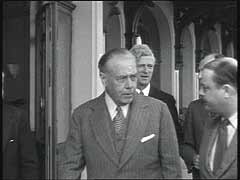
The postwar movement of about 250,000 mainly eastern European Jewish survivors to displaced persons camps and to the West, with the goal of reaching Palestine, was known as the "Brihah" ("flight"). Here, Jewish refugees cross illegally into Italy, probably to charter a ship to sail to Palestine. The British restricted Jewish immigration into Palestine and deported "illegal" immigrants to detention camps in Cyprus.
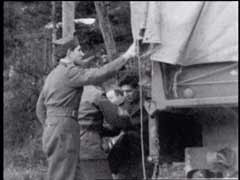
After the defeat of Germany, the Allies tried leading state and party officials and military commanders of the Third Reich before a tribunal of military judges from the Soviet Union, Great Britain, France, and the United States. This International Military Tribunal tried 22 major war criminals during what is commonly known as the Nuremberg Trial, which lasted from November 1945 to October 1946. This footage shows the accused entering pleas following their indictment on charges of crimes against peace, war…
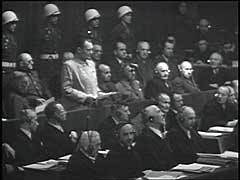
Hermann Göring was head of the German air force. He was one of 22 major war criminals tried by the International Military Tribunal at Nuremberg. Here, Göring testifies about his order of July 31, 1941, authorizing Reinhard Heydrich, head of the Reich Security Main Office, to plan a so-called "solution to the Jewish question in Europe." The Tribunal found Göring guilty on all counts and sentenced him to death. Göring committed suicide shortly before his execution was to take place.
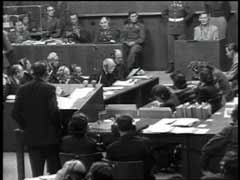
The Medical Case was one of 12 war crimes trials held before an American tribunal as part of the Subsequent Nuremberg Proceedings. On trial were doctors and nurses who had participated in the killing of physically and mentally impaired Germans and who had performed medical experiments on people imprisoned in concentration camps. Here, concentration camp survivors Maria Kusmierczuk and Jadwiga Dzido, who had been victims of these experiments, show their injuries to the court as evidence.
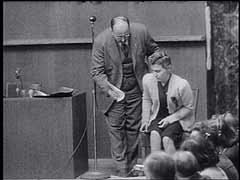
After the trial of major war criminals before the International Military Tribunal in Nuremberg, the United States held a series of other war crimes trials at Nuremberg—the Subsequent Nuremberg Proceedings. The ninth trial before the American military tribunal in Nuremberg focused on members of the Einsatzgruppen (mobile killing units), who had been assigned to kill Jews and other people behind the eastern front. This footage shows US prosecutor Ben Ferencz outlining the purpose of the trial during…
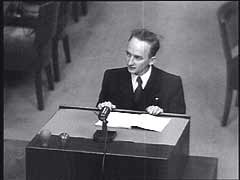
After the trial of major war criminals before the International Military Tribunal in Nuremberg, the United States held a series of other war crimes trials at Nuremberg—the Subsequent Nuremberg Proceedings. The ninth trial before the American military tribunal in Nuremberg focused on members of the Einsatzgruppen (mobile killing units), who had been assigned to kill Jews and other people behind the eastern front. In this footage of the prosecution's opening statement, US prosecutor Ben Ferencz explains…
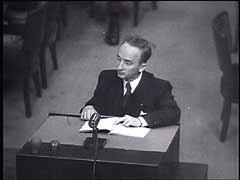
Vidkun Quisling headed the German-controlled government of Norway from 1942-1945. Because of his actions, his name became synonymous with Nazi collaboration.

Nazi supporters parade at a campaign rally in Waldenburg, Germany. In a speech, Hitler attacks the Weimar Republic and pledges to dissolve the parliamentary system soon after he gains power.
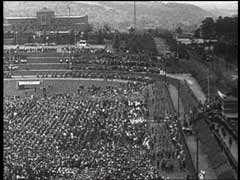
In their drive to rid the country of all that they deemed "un-German," the Nazis publically burned books in cities across Germany. Here in front of the Opera House in Berlin, a chanting crowd burns books written by Jews and leftist intellectuals. Joseph Goebbels, Hitler's minister of propaganda and public information, speaks of the intended "reeducation" of Germany.
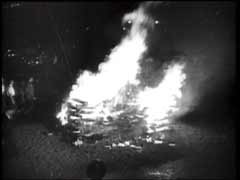
Adolf Hitler's foreign policy aimed at establishing a European empire for Germany through war. This policy required the rapid expansion of Germany's military capabilities. The Geneva Disarmament Conference, beginning in 1932, sought to avoid another European war by negotiating a reduction in armaments. Hitler repudiated this effort by withdrawing Germany from the conference in October 1933. At the same time, he rejected collective security in international affairs by withdrawing from the League of Nations.…
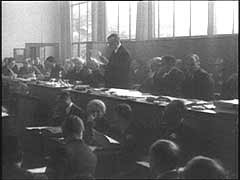
Provisions of the 1919 Treaty of Versailles forbade Germany (defeated in World War I) to station armed forces in a demilitarized zone in the Rhineland—a region in western Germany bordering France, Belgium, and part of the Netherlands. The treaty stipulated that Allied forces—including US troops—would occupy the region. In a blatant violation of the treaty, on March 7, 1936, Hitler ordered German troops to reoccupy the zone. Hitler gambled that the western powers would not intervene. His action…
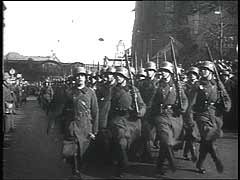
In 1933, Nazi Party leader Adolf Hitler became chancellor of Germany and quickly turned the nation's fragile democracy into a one-party dictatorship. Police rounded up thousands of political opponents, detaining them without trial in concentration camps. The Nazi regime also put into practice racial policies that aimed to "purify" and strengthen the Germanic "Aryan" population. A relentless campaign began to exclude Germany's one-half million Jews from all aspects of German life. For two weeks in August…
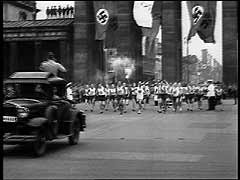
Upon arrival in the Auschwitz camp, victims were forced to hand over all their belongings. Inmates' belongings were routinely packed and shipped to Germany for distribution to civilians or use by German industry. The Auschwitz camp was liberated in January 1945. This Soviet military footage shows civilians and Soviet soldiers sifting through possessions of people deported to the Auschwitz killing center.
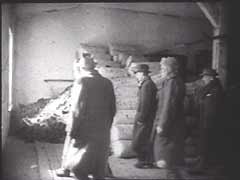
Eva Justin was an assistant to Dr. Robert Ritter, the Third Reich's "expert" on Roma (Gypsies). She studied these Romani (Gypsy) children as part of her dissertation on the racial characteristics of Roma. The children stayed at St. Josefspflege, a Catholic children's home in Mulfingen, Germany. Justin completed her study shortly after this film was taken. The children were deported to Auschwitz-Birkenau, where most were killed.
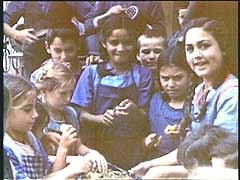
The Hadamar psychiatric hospital was used as a euthanasia killing center from January until August 1941. Nazi doctors gassed about 10,000 German patients there. Although systematic gassings ended in September 1941, the killing of patients continued through the end of the war. In this footage, American soldiers supervise the exhumation of the cemetery at Hadamar and begin the interrogation of Dr. Adolf Wahlmann and Karl Wilig, who participated in the killings.
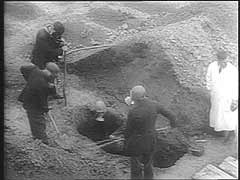
[This video is silent] The Dachau concentration camp, northwest of Munich, Germany, was the first regular concentration camp the Nazis established in 1933. About twelve years later, on April 29, 1945, US armed forces liberated the camp. There were some 30,000 starving prisoners in the camp at the time. This footage shows an aerial view of the camp and the entrance gate to the prisoner compound.
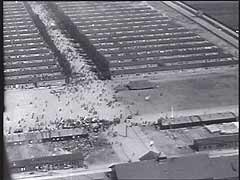
In Nazi usage, "euthanasia" referred to the killing of those whom the Nazis deemed "unworthy of life." In 1941 the Hadamar psychiatric clinic served as one of the euthanasia killing centers in Germany. Patients selected by German doctors for euthanasia were transferred to Hadamar or one of the other facilities and were killed in gas chambers. Over 10,000 people were gassed at Hadamar before the Euthanasia Program officially ended in August 1941. Although the program had officially ended, killings continued…
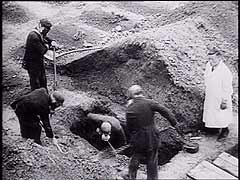
After the trial of major war criminals before the International Military Tribunal in Nuremberg, the United States held a series of other war crimes trials at Nuremberg during the Subsequent Nuremberg Proceedings.The ninth trial of these proceedings, before an American military tribunal, focused on members of the Einsatzgruppen (mobile killing units) who had been assigned to kill Jews and other people behind the eastern front. This footage shows US Supreme Court Justice Robert Jackson, chief prosecutor for…
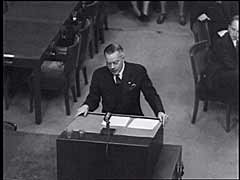
British troops liberated the Bergen-Belsen concentration camp in Germany in April 1945. They filmed statements from members of their own forces. In this British military footage, British army chaplain T.J. Stretch recounts his impressions of the camp.
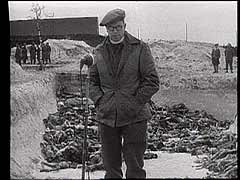
Japanese pilots used the tactic of Kamikaze (suicidal) dive-bombing attacks on enemy warships in 1944 and 1945. The "USS Nevada," despite an escort and efforts to fight off a Kamikaze attack, sustained such a hit in early 1945 off the coast of Japan. The "USS Ticonderoga," a carrier, also sustained such a hit in early 1945 off Formosa (Taiwan). The impact of Kamikaze attacks decreased during the final months of the war in the Pacific, in part because of an improvement in Allied evasion tactics.
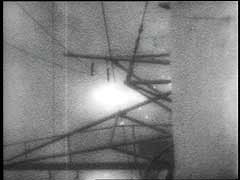
Japanese forces took the Philippine islands between December 1941 and May 1942. After US naval victory in the Battle of Midway (June 1942), Allied forces slowly gained naval and air supremacy in the Pacific war. In October 1944, US forces began the liberation of the Philippines. The campaign on Luzon, largest and most northern of the islands, began in December 1944. This battle footage shows many Japanese soldiers being taken as prisoners of war.

World War II in the Pacific theater ended with the Japanese surrender on September 2, 1945. The surrender was signed in Tokyo Bay aboard the American battleship USS "Missouri." Foreign Minister Shigemitsu headed the Japanese delegation. General Douglas MacArthur accepted the surrender on behalf of the Allies. Admiral Nimitz signed for the US and Admiral Fraser for Britain. Representatives of all the Allied nations attended the signing.

The German-Soviet Pact of August 1939 included a nonaggression pact whereby Germany and the Soviet Union promised not to attack one another for 10 years. Germany was thus able to invade Poland on September 1, 1939, without fear of Soviet intervention. In accordance with secret provisions of the pact, Poland was partitioned between Germany and the Soviet Union. Soviet forces occupied eastern Poland. In this footage, German and Soviet forces meet along the Bug River in central Poland. Less than two years…
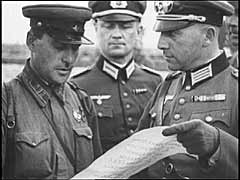
Massive Allied landings of air- and sea-borne forces on five Normandy beaches (codenamed Utah, Omaha, Gold, Juno, and Sword) began on June 6, 1944 (D-Day). The purpose of the invasion was to establish a bridgehead from which Allied forces could break out and liberate France. By the end of the operation's first day, some 150,000 troops were ashore in Normandy. This footage shows Allied forces landing on the Normandy beaches.
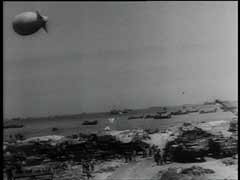
Allied air superiority over Germany was a decisive factor in the success of the D-Day (June 6, 1944) landings in France. This footage shows the Allied bombing of suspected German positions during the battle. Allied air attacks both supported Allied ground operations in Normandy and prevented German reinforcements from reaching the area. The Allies would liberate most of France by the end of August 1944.
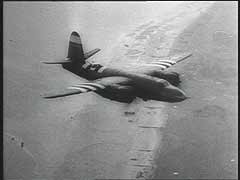
The German army (Wehrmacht) regarded the war in the east as a crusade against communism and not subject to the "normal rules" of war. After the German invasion of the Soviet Union in June 1941, Soviet soldiers followed a "scorched earth" policy to hinder the German advance. In this German newsreel footage, German soldiers approach a burning village, one of many destroyed during the invasion of the Soviet Union.
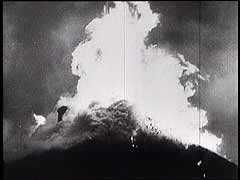
German forces launched Operation "Barbarossa," the invasion of the Soviet Union, on June 22, 1941. The German army made rapid initial progress in the campaign into Soviet territory. In this German military footage, German soldiers separate women and children from men in a Soviet village.
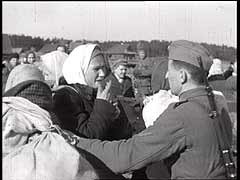
Soviet troops entered the Auschwitz killing center in January 1945 and liberated thousands of sick and exhausted prisoners. This Soviet military footage was filmed shortly after the camp was liberated. It shows Soviet doctors examining victims of sterilization, poisonous injection, and skin graft experiments.
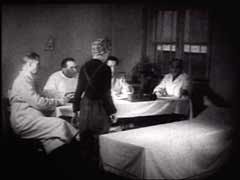
The Medical Case was one of 12 war crimes trials held before an American tribunal as part of the Subsequent Nuremberg Proceedings. The trial dealt with doctors and nurses who had participated in the killing of physically and mentally impaired Germans and who had performed medical experiments on people imprisoned in concentration camps. Here, chief prosecutor Brigadier General Telford Taylor reads into evidence a July 1942 report detailing Nazi high-altitude experiments and outlines the prosecution's goals…
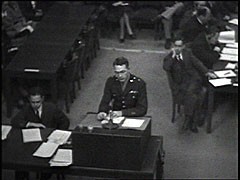
The Medical Case was one of twelve war crimes trials held before an American tribunal as part of the Subsequent Nuremberg Proceedings. The trial dealt with doctors and nurses who had participated in the killing of physically and mentally impaired Germans and who had performed medical experiments on people imprisoned in concentration camps. Sixteen of the defendants were found guilty. Of the sixteen, seven were sentenced to death for planning and carrying out experiments on human beings against their will.…

The Soviet Union occupied Lvov in September 1939, according to secret provisions of the German-Soviet Pact. Germany invaded the Soviet Union on June 22, 1941. After a week of bitter fighting, German forces occupied Lvov. They discovered that the Soviet Secret Police had massacred thousands of prisoners, mostly Ukrainian nationalists, before fleeing from the city. This footage shows the removal of the bodies of some of those massacred. The Germans claimed that the city's Jewish population had supported the…
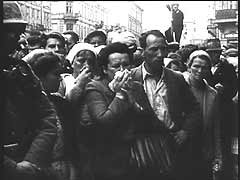
The Soviet Union occupied Lvov in September 1939, according to secret provisions of the German-Soviet Pact. Germany invaded the Soviet Union on June 22, 1941, occupying Lvov within a week. The Germans claimed that the city's Jewish population had supported the Soviets. Ukrainian mobs went on a rampage against Jews. They stripped and beat Jewish women and men in the streets of Lvov. Ukrainian partisans supported by German authorities killed about 4,000 Jews in Lvov during this pogrom. US forces discovered…
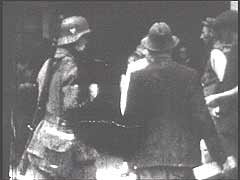
Julius Streicher, Nazi leader and publisher of the antisemitic newspaper "Der Stuermer" (The Attacker), makes a speech accusing Jews of trying to control the world and living by the exploitation of non-Jews. According to Streicher, the only answer for Germany is to solve the "Jewish question."
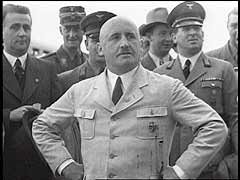
Hitler speaks before the Reichstag (German parliament). Amid rising international tensions, he tells the German public and the world that the outbreak of war would mean the end of European Jewry.
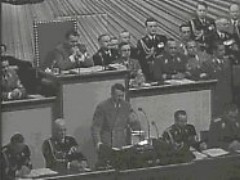
In Berlin, Germany, officials from Nazi Germany, Fascist Italy, and Imperial Japan sign the ten-year Tripartite Pact (the Three-Power Agreement), a military alliance. The pact sealed cooperation among the three nations (Axis powers) in waging World War II. This footage comes from "The Nazi Plan," a film produced and used by the United States in the prosecution at the Nuremberg trials.
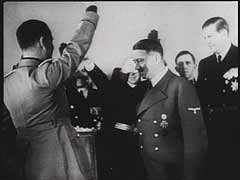
In 1936, Germany and Italy signed a military alliance. The two powers formed the so-called Berlin-Rome Axis. This footage shows Italian Fascist leader Benito Mussolini's state visit to Germany in September 1937. He met with Hitler in Munich and the two leaders also toured other parts of Germany. During the state visit, Mussolini attended a military parade in Berlin, Germany's capital. Although both dictators declared their desire for peace, Germany would begin World War II in 1939. Italy would then enter…
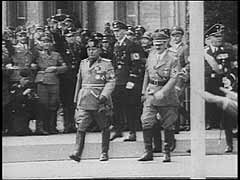
Most Allied prisoners of war (POWs) were treated well compared to inmates of concentration camps. But, as former Dutch POW Captain Boullard explains here at Dachau concentration camp, some were subject to severe beatings and forced to work in harsh labor assignments.
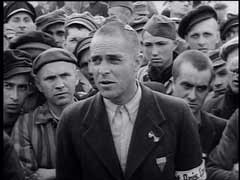
Germany launched its western offensive on May 10, 1940. German paratroopers landed in the Netherlands on the first day of the German attack on that country. They seized key bridges and fortifications, compromising Dutch defensive positions. This footage shows the German air force (Luftwaffe) dropping paratroopers near Rotterdam. Within days, the Netherlands was defeated. The country surrendered to Germany on May 14. The Dutch government and Queen Wilhelmina fled to exile in Great Britain.
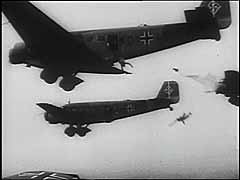
German forces invaded western Europe in May 1940. As part of their strategy to defeat Britain and France, German forces invaded neutral Belgium. Little more than two weeks after the German invasion of Belgium, King Leopold III ordered the surrender of the Belgian army. In this footage a Belgian officer signs the surrender and thousands of refugees flood the streets as German forces move through Belgium.

Germany invaded France in May 1940. This footage shows German tanks, artillery, and divebombers attacking the Maginot Line, a series of French fortifications intended to protect France's border with Germany. The main German assault, however, went to the north through Luxembourg and bypassed the Maginot Line. German forces entered Paris on June 14, 1940. Little more than a week later, defeated France signed an armistice with Germany.
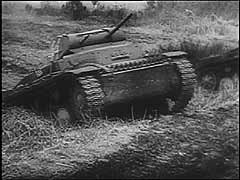
The German western campaign in May 1940 decisively defeated the British and French forces arrayed against it. By the end of May, the Allies began the withdrawal of British and French forces from the Continent to prevent their surrender or destruction. The evacuation effort centered on the French coastal town of Dunkirk. As German forces completed their conquest of France, more than 1,000 vessels--including small civilian yachts and fishing boats--ferried Allied forces across the English Channel to Great…
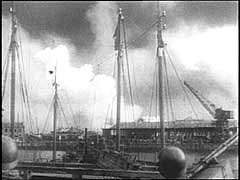
After the defeat of France in June 1940, Germany moved to gain air superiority over Great Britain as a prelude to an invasion of Britain. Despite months of air attacks, Germany was not able to destroy Britain's Royal Air Force (RAF). In the fall of 1940, the invasion was indefinitely postponed. The German bombing campaign against Britain continued until May 1941. The Germans ultimately halted the air attacks primarily because of preparations for the invasion of the Soviet Union in June 1941.
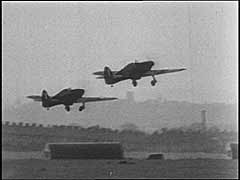
After the defeat of France in June 1940, Germany moved to gain air superiority over Great Britain as a prelude to an invasion of Britain. During almost nightly German air raids (known as "the Blitz") on London, the civilian population of the city sought refuge--as shown in this footage--in air raid shelters and in London's subway system (called the "Underground" or the "Tube"). Despite months of air attacks, Germany was not able to destroy Britain's Royal Air Force (RAF). In the fall of 1940, the invasion…
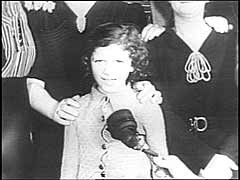
Adolf Hitler became chancellor of Germany in January 1933. Soon thereafter, terror actions against opponents of Nazism began: Jews were a major target in these campaigns. Many Jews were subjected to public humiliation or arrest, and others were forced to quit their posts. Anti-Jewish measures climaxed with the April 1, 1933, boycott of Jewish-owned businesses. This footage depicts a Jewish anti-Nazi march in Chicago.
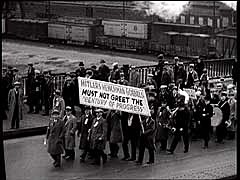
The American Jewish Congress was among the first groups in the United States to oppose Nazism. It held a mass rally as early as March 1933, soon after Hitler rose to power in Germany, and continued to hold rallies throughout the war years. The American Jewish Congress organized this anti-Nazi march through Lower Manhattan. The event coincided with book burning in Germany.
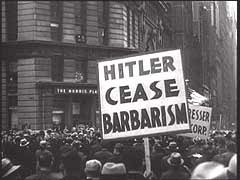
On November 9, 1938, the Nazis led a nationwide pogrom against Jews. During the pogrom, known as "Kristallnacht" (the "Night of Broken Glass"), bands of Storm Troopers (SA) destroyed thousands of Jewish-owned businesses and hundreds of synagogues. Almost 100 Jews were killed in the process. This footage shows scenes from a protest rally in New York City. Rabbi Stephen S. Wise voiced the outrage of the American Jewish community. As part of an official protest by the United States government against the…
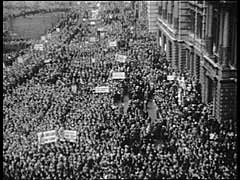
Although constrained by powerful isolationist sentiment in the United States, President Roosevelt was determined to help democratic Great Britain continue the war against Nazi Germany. Even as he promised to keep the United States neutral in the European war, Roosevelt ordered the expansion of military construction and pledged--as shown in this footage--that the United States would serve as the "great arsenal of democracy." In March 1941, Congress approved Lend-Lease aid for Britain. Britain ultimately…
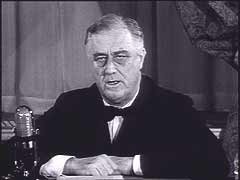
We would like to thank Crown Family Philanthropies, Abe and Ida Cooper Foundation, the Claims Conference, EVZ, and BMF for supporting the ongoing work to create content and resources for the Holocaust Encyclopedia. View the list of donor acknowledgement.